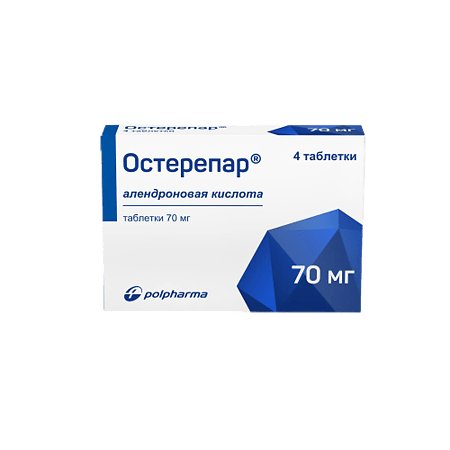No products in the cart.
Osterepar, tablets 70 mg 4 pcs
€13.38 €11.71
Description
Alendronate sodium is a bisphosphonate, a synthetic analog of pyrophosphate binding hydroxyapatite of bone tissue. Being a non-hormonal specific inhibitor of osteoclast activity, it prevents bone tissue resorption. It does not influence bone tissue formation processes.
Stimulates osteogenesis, restores positive balance between resorption and bone regeneration.
Progressively increases bone mineral density (regulates phosphorus-calcium exchange), promotes formation of bone tissue of normal composition and structure.
Indications
Indications
Treatment of postmenopausal osteoporosis to prevent spine and hip fractures.
Pharmacological effect
Pharmacological effect
Sodium alendronate is a bisphosphonate, a synthetic analogue of pyrophosphate, which binds bone hydroxyapatite. Being a non-hormonal specific inhibitor of osteoclast activity, it prevents bone tissue resorption. Does not affect the processes of bone tissue formation.
Stimulates osteogenesis, restores a positive balance between bone resorption and restoration.
Progressively increases bone mineral density (regulates phosphorus-calcium metabolism), promotes the formation of bone tissue of normal composition and structure.
Active ingredient
Active ingredient
Alendronic acid
Composition
Composition
Active ingredient: sodium alendronate trihydrate 91.37 mg (corresponds to 70 mg alendronic acid);
Excipients: lactose monohydrate, microcrystalline cellulose, croscarmellose sodium, magnesium stearate, colloidal anhydrous silica
Contraindications
Contraindications
Hypersensitivity to any of the components of the drug;
abnormalities of the esophagus and other factors that impede the patency of the esophagus (achalasia, stricture, etc.);
the patient’s inability to remain in an upright position, even sitting, for 30 minutes; hypocalcemia, chronic renal failure (creatinine clearance < 35 ml/min),
pregnancy, lactation, childhood, vitamin D deficiency, severe disorders of mineral metabolism.
With caution: diseases of the digestive tract in the acute phase (dysphagia, diseases of the esophagus, gastritis, duodenitis, ulcers, serious disease of the gastrointestinal tract in the previous 12 months, for example, peptic ulcer, gastrointestinal bleeding, surgery, with the exception of operations on the spastic pylorus of the stomach).
Side Effects
Side Effects
Body as a whole: hypersensitivity reactions, including urticaria and rare cases of angioedema; transient symptoms of myalgia, malaise, asthenia and, rarely, cases of fever, usually at the beginning of treatment; rarely – peripheral edema.
From the gastrointestinal tract: esophagitis, erosions and ulcers of the esophagus; rarely – stenosis or perforation of the esophagus, oropharyngeal ulcers, gastric or duodenal ulcers; Rare cases of localized osteonecrosis of the jaw have been reported, usually associated with tooth extraction and/or local infection, often with delayed healing.
From the musculoskeletal system: pain in bones, joints and/or muscles, sometimes severe and, rarely, leading to disability.
From the nervous system and sensory organs: dizziness, vertigo; rarely – uveitis, scleritis or episcleritis.
From the skin: rash (sometimes with photosensitivity), itching; rarely – severe skin reactions, including Stevens-Johnson syndrome and toxic epidermal necrolysis.
Interaction
Interaction
Calcium, antacids, some oral medications, food, drinks, incl. mineral waters affect the absorption of alendronate. Medicines can be taken orally no earlier than 1 hour after taking alendronate.
Other types of interaction, with the exception of changes in absorption, are unlikely.
Ranitidine increases the bioavailability of alendronate (clinical significance unknown).
NSAIDs increase the adverse effects of alendronic acid.
No specific drug interaction studies have been conducted, but studies with alendronate included patients taking other oral medications at the same time. At the same time, they did not experience any adverse reactions associated with the simultaneous use of other drugs.
Overdose
Overdose
Symptoms: hypocalcemia, hypophosphatemia, adverse reactions from the upper gastrointestinal tract (heartburn, esophagitis, gastritis, ulcer).
Treatment: There is no specific treatment. It is recommended to take milk and antacids. To avoid irritation of the esophagus, vomiting should not be induced; the patient should take an upright position (standing or sitting).
Storage conditions
Storage conditions
In a dry place, protected from light, at a temperature not exceeding 25 °C
Shelf life
Shelf life
2 years
Manufacturer
Manufacturer
Polpharma JSC, Poland
Additional information
| Shelf life | 2 years |
|---|---|
| Conditions of storage | In a dry, light-protected place at a temperature not exceeding 25 °C |
| Manufacturer | Polpharma S.A., Poland |
| Medication form | pills |
| Brand | Polpharma S.A. |
Related products
Buy Osterepar, tablets 70 mg 4 pcs with delivery to USA, UK, Europe and over 120 other countries.













